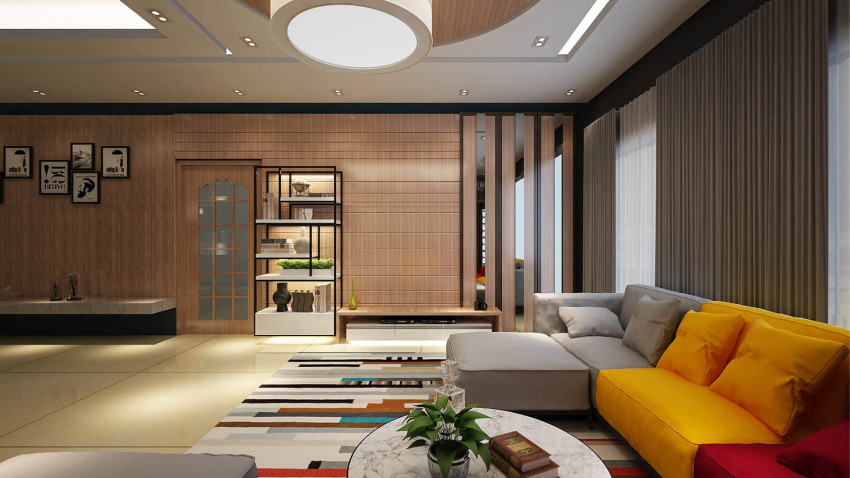
Multi-Functional Furniture
Invest in furniture that serves multiple purposes to make the most of limited space. Consider a sofa that converts into a bed, a coffee table with hidden storage, or wall-mounted desks that fold away when not in use. Multi-functional furniture helps maximize the functionality of a small space without sacrificing style.
Vertical Storage Solutions
Utilize vertical space to create efficient storage solutions for your home interior design. Install wall-mounted shelves, floating cabinets, or tall bookcases to keep belongings organized and off the floor. Vertical storage not only maximizes space but also draws the eye upward, creating an illusion of height and openness.
Light Color Palette
Opt for a light color palette to make small spaces feel more open and airy. Whites, pastels, and neutral tones reflect light, creating a brighter and more expansive atmosphere. Consider using light colors for walls, furniture, and decor to visually expand the space and create a cohesive look.
Strategic Mirror Placement
Incorporate mirrors strategically to enhance the perception of space. Placing mirrors opposite windows reflects natural light and makes the room feel larger. Consider mirrored furniture or decor pieces to add a touch of elegance while contributing to the illusion of spaciousness.
Customized Built-In Storage
Maximize every inch of available space by incorporating customized built-in storage. Utilize alcoves, under-stair spaces, and wall niches for built-in shelves, cabinets, or drawers. Tailor the storage solutions to your specific needs, ensuring that every corner serves a purpose.
Flexible Room Dividers
Divide open spaces with flexible room dividers that maintain an airy feel. Consider options like sliding doors, folding screens, or bookshelves that act as both dividers and storage. These solutions allow you to create separate zones within a small space while maintaining a sense of openness.
Dual-Purpose Rooms
Combine functionality by incorporating dual-purpose rooms. For example, a home office can double as a guest room with a pull-out sofa or a wall bed. Similarly, a dining area can be integrated into the kitchen or living room, optimizing space for both daily activities and occasional needs.
Utilize Under-Bed Storage
Make use of the often-overlooked space under the bed for additional storage. Choose beds with built-in drawers or add discreet under-bed storage bins. This area is ideal for stowing away seasonal clothing, extra linens, or items that are not frequently used.
Foldable and Stackable Furniture
Opt for furniture that can be easily folded or stacked when not in use. Folding chairs, collapsible tables, and stackable stools provide flexibility in arranging your space. These pieces can be tucked away to create more room when entertaining or engaging in other activities.
Open Shelving
Open shelving adds a sense of openness to a small space while providing storage for everyday items. Displaying items on open shelves can also contribute to the overall decor. Choose aesthetically pleasing containers and baskets to keep the shelving organized and visually appealing.
Concealed Storage Solutions
Incorporate concealed storage solutions to maintain a clean and clutter-free look. Furniture with hidden compartments, ottomans with storage space, or benches with lift-up seats are effective ways to keep essential items close at hand while minimizing visual distractions.
Floating Furniture
Create the illusion of more floor space by using floating furniture. Wall-mounted shelves, floating desks, and floating entertainment units free up floor space and give the room a modern and uncluttered appearance. This design choice is especially effective in small bedrooms or living rooms.
Smart Technology Integration
Embrace smart technology to streamline and optimize small spaces. Invest in smart home systems that control lighting, climate, and entertainment with minimal physical components. This reduces the need for bulky devices and allows you to create a sleek and minimalist aesthetic.
Compact and Nesting Furniture
Choose compact and nesting furniture that can be easily moved or stored when not in use. Nesting tables, stackable chairs, and compact kitchen appliances are perfect for small spaces where flexibility is key. These pieces can be arranged to suit your needs and then tucked away when additional space is required.
Monochromatic Color Schemes
Stick to a monochromatic color scheme to create a cohesive and visually harmonious environment. Using variations of a single color throughout the space reduces visual distractions and promotes a sense of continuity. This design strategy contributes to a serene and uncluttered atmosphere.
Minimalist Design Principles
Embrace minimalist design principles to achieve a clean and uncluttered look. Focus on essential pieces that serve a purpose and declutter unnecessary items. A minimalist approach emphasizes quality over quantity, creating a serene and sophisticated small space.
Portable and Foldable Workspaces
If space allows, consider incorporating portable and foldable workspaces. These can be easily moved around or folded up when not in use. A fold-down desk or a wall-mounted work surface provides a functional workspace without sacrificing valuable floor space.
Maximize Natural Light
Make the most of natural light to enhance the openness of a small space. Choose sheer curtains or blinds that allow ample light to filter through. Keep windows unobstructed to maximize views and create a brighter, more inviting atmosphere.
Adaptable Furniture for Growing Needs
Select furniture that can adapt to changing needs. Consider pieces that can be modified or expanded to accommodate new functionalities. Adaptable furniture ensures that your space remains versatile and can evolve with your lifestyle.
Personalized and Purposeful Decor
Be intentional with your decor choices and select pieces that hold personal significance. Avoid overcrowding small spaces with unnecessary decor items. Each piece should serve a purpose or hold sentimental value, contributing to a curated and meaningful interior.
In conclusion, small spaces offer a unique opportunity for creative and purposeful design. By implementing these clever strategies, you can transform compact living areas into stylish, functional, and inviting spaces that reflect your personal style while making the most of every square foot.



